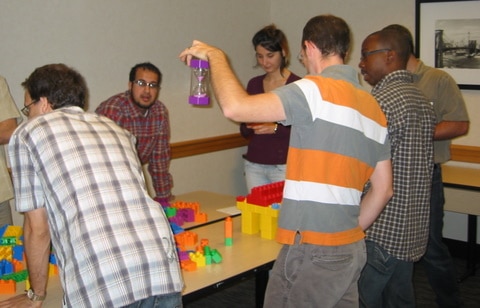I wrote this to help explain to the different types of approaches companies adopt when getting started with Agile: books, training or coaching. This is based on my experiences, so I’d like to hear from you. Permanent page is here.
1) Do it yourself
It’s possible to get started with Agile the way many people did after the Agile Manifesto was published in 2001: buy some books and start reading them. Today, there’s a lot more to choose from. As well, there is a lot free online learning material: articles, videos, blogs. I have provided links and bibliography under Agile Learning Resources.
2) Train the team and kick start the project
 A good way to get started with Agile is to find an Agile coach to train and launch you project. It’ll take 2-3 days to get a couple of teams trained on-site. (This will be a lot cheaper than public training). Depending on the size and state of the project, it may take 3+ days to launch or restart the project using Agile techniques.
A good way to get started with Agile is to find an Agile coach to train and launch you project. It’ll take 2-3 days to get a couple of teams trained on-site. (This will be a lot cheaper than public training). Depending on the size and state of the project, it may take 3+ days to launch or restart the project using Agile techniques.
3) Hire a coach to transition to Agile
 The best way to get started is work with an Agile coach to get your team operational and self-sufficient. You’ll want start by training your people and kick start your project (as above). It will take a while before your team is able to fully internalize the values and principles. Depending on how much attention you pay to technical practices, these can take a while to put in place. This approach involves having a full-time coach (or even a pair) work with your teams to accelerate learning and avoid pitfalls. Your coach will work with you to set transition objectives, so you’ll know how things are going and know where they are adding value.
The best way to get started is work with an Agile coach to get your team operational and self-sufficient. You’ll want start by training your people and kick start your project (as above). It will take a while before your team is able to fully internalize the values and principles. Depending on how much attention you pay to technical practices, these can take a while to put in place. This approach involves having a full-time coach (or even a pair) work with your teams to accelerate learning and avoid pitfalls. Your coach will work with you to set transition objectives, so you’ll know how things are going and know where they are adding value.
Comparison of Alternatives
| Approach | Advantages | Disadvantages |
|---|---|---|
Do it yourself |
|
|
Train the team and kick start the project |
|
|
Hire a coach to transition to Agile |
|
|
Other perspectives
- CIO Magazine’s 7 Agile Leadership Lessons for the Suits
- George Schlitz has an excellent post that explains why Professional Teams Need Coaches
- Scrum Alliance article on Top Ten Organizational Impediments to adopting Agile
- Presentation on Agile Adoption Patterns And Antipatterns


